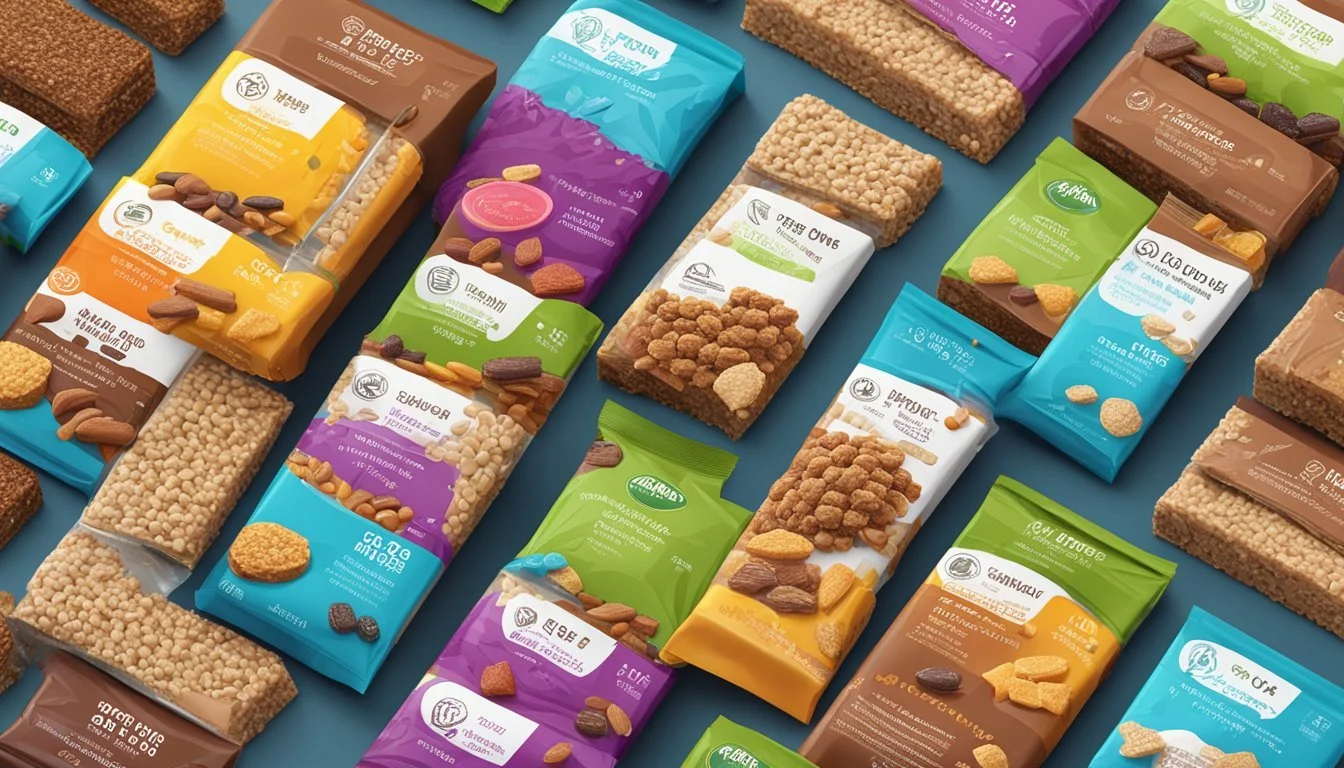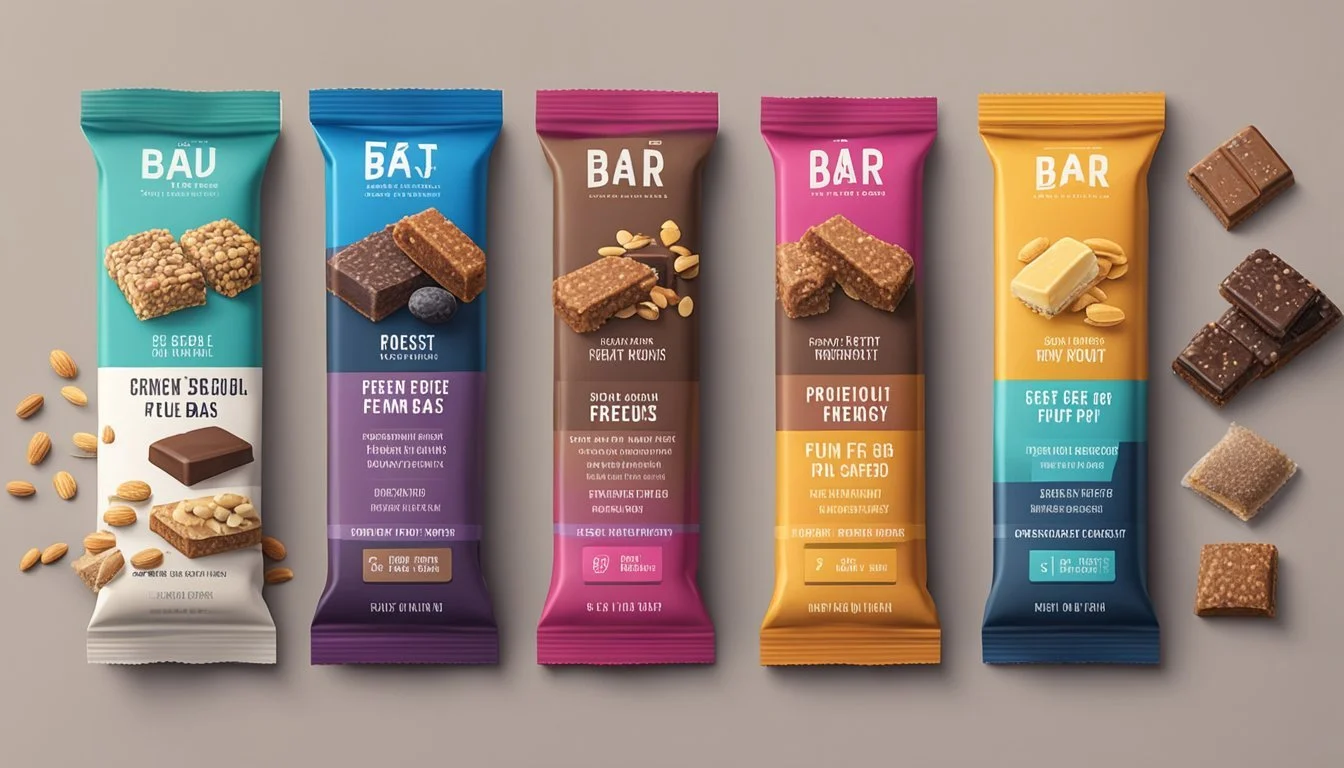The Best Grain-Free Energy Bars for Pre- and Post-Workout
Optimal Nutrition On-The-Go
Selecting the right energy bar that aligns with one's dietary preferences can be instrumental in achieving fitness goals. Grain-free energy bars offer an alternative for those looking to fuel their workouts without grains. Typically, these bars are formulated with nuts, seeds, and various binders to provide a concentrated source of energy and nutrients. They cater to individuals who either have grain sensitivities or simply choose to omit grains from their diet for personal health reasons.
Consuming the appropriate pre-workout snack can help ensure that the body has enough energy for endurance and performance, while a good post-workout snack aids in recovery and muscle repair. Grain-free energy bars are ideal in both scenarios as they often contain a balanced blend of proteins, healthy fats, and carbohydrates, providing a quick and convenient source of nutrition that can help enhance exercise outcomes.
While traditional snacks might rely on grain-based components for texture and bulk, grain-free options offer a similar experience without compromising on taste or nutritional value. Whether before an intense gym session or after a challenging workout, grain-free energy bars serve as a practical choice for supporting an active lifestyle.
Discovering the best grain-free energy bars for pre- and post-workout offers a delightful exploration into flavorful and nourishing options. Navigating the diverse offerings in the market, you can find a variety of energy bars that align with a grain-free lifestyle. Engaging with knowledgeable grain-free food bloggers can offer valuable insights and inspiration, providing a community of support and innovative ideas for incorporating these bars into your fitness routine.
Whether enjoyed as a convenient and energizing addition to wholesome grain-free snacks or as part of a carefully crafted grain-free meal planning approach, these bars can be a versatile and enjoyable part of a grain-free lifestyle. By incorporating them into your dietary choices, you can support your fitness goals, including grain-free weight loss and understanding the grain-free gluten-free difference.
For those following a grain-free keto or grain-free plant-based protein lifestyle, these energy bars can offer a satisfying and health-conscious way to fuel your workouts and recovery. The best grain-free energy bars can provide a flavorful and nourishing option for your pre- and post-workout needs, supporting your health and fitness journey.
Benefits of Grain-Free Energy Bars
Grain-free energy bars offer a specialized alternative to traditional snack options, providing essential nutrients without relying on conventional grain sources. They cater to various dietary needs while supplying the body with necessary fuel and nutrients.
Nutritional Advantages
Protein: Grain-free bars are often rich in protein, crucial for muscle repair, especially after strength training. They usually derive their protein content from nuts, seeds, or plant-based options, making them suitable for vegans and those who avoid dairy.
Carbohydrates: Despite being grain-free, these bars provide carbohydrates from sources like dates and other fruits, which are vital for replenishing glycogen stores post-workout.
Fiber: Ingredients such as chia seeds and nuts contribute to the fiber content, important for digestive health and maintaining stable blood sugar levels.
Fats: Healthy fats from sources like nuts provide sustained energy without spiking blood sugar.
Calories: Designed to be calorie-dense, these bars offer quick, easy to consume energy that fits well into the health and fitness routines of athletes and fitness enthusiasts.
Nutrient Profile Table:
Nutrient Common Sources in Grain-Free Bars Benefit Protein Nuts, Seeds, Pea Protein Muscle repair Carbs Dates, Other Fruits Energy replenishment Fiber Nuts, Chia Seeds Digestive health Fats Nuts, Seeds Sustained energy
Health and Fitness Impact
Blood Sugar: The low-to-moderate glycemic index of grain-free energy bars helps in maintaining stable blood sugar, which is critical for endurance activities and overall health.
Muscle: The protein content in these bars plays a role in supporting muscle synthesis and recovery after workouts.
Weight Management: The mix of protein, fats, and fiber can contribute to satiety, which may assist with weight management goals.
Fuel: As a pre-workout snack, grain-free energy bars provide convenient fuel without the bloating that can accompany grain-based options.
Dietary Considerations
Vegan and Gluten-Free: Many grain-free bars are made with vegan and gluten-free ingredients, catering to those with specific dietary restrictions or allergies.
Non-GMO and Organic: There is a growing preference for non-GMO and organic ingredients in grain-free bars, as they align with a focus on overall health and environmental consciousness.
Free From Common Allergens: Options are available which are dairy-free, nut-free, and otherwise tailored to avoid common allergens, ensuring they are accessible to a wide range of consumers concerned with health and clean eating.
Nutrient Density: These bars often emphasize the importance of nutrient density over caloric density, therefore providing more of the essential nutrients with fewer unnecessary calories and sugars.
Key Ingredients and Their Roles
Selecting the right ingredients for grain-free energy bars ensures that they provide sustained energy, necessary nutrients, and are palatable. The composition often includes a balance of proteins and fats, natural sweeteners, carbohydrates, nutrition enhancers, and hydration elements, which collectively meet the performance needs of individuals.
Proteins and Fats
Proteins are essential for muscle repair and recovery, often sourced from protein powder, whey protein, or plant-based alternatives. Nuts and seeds are favorite fats in energy bars, which not only enhance taste but also supply omega-3 fatty acids crucial for heart health.
Protein Sources: whey protein, protein powder, chia seeds
Fats: nuts (almonds, walnuts), seeds (pumpkin, chia, flax)
Natural Sweeteners
Natural sweeteners provide a palatable flavor without the need for refined sugars. Fruit such as dates or dried versions like berries, dried fruit, or dark chocolate can offer this sweetness, alongside fiber and nutrients.
Sweetness: dates, dried berries, dark chocolate
Sugar Alcohols: xylitol, erythritol (to reduce sugar content)
Carbs for Energy
Carbs serve as the primary fuel source for physical activities. Grain-free options may include sweet potatoes or fruit, which deliver energy and necessary dietary fiber.
Carbs: fruit (banana, apple), root vegetables (sweet potato)
Nutrition Enhancers
Adding seeds like chia or ingredients high in calcium and potassium introduces essential minerals. Antioxidants from berries or dark chocolate contribute to reducing oxidative stress during and after workouts.
Fiber and Omega-3: chia seeds, flax seeds
Antioxidants: dark chocolate, dried berries
Hydration Elements
Maintaining hydration is critical during exercise. Ingredients that contain electrolytes, such as potassium, help in replenishing lost minerals through sweat.
Electrolytes: coconut water powder, salt (in moderation)
Water Content: high water content fruits like apple, orange
Combining these ingredients strategically creates a grain-free energy bar that not only provides the necessary nutrition and energy for pre- and post-workout but also satisfies the taste and texture preferences of the consumer.
Post-Workout Recovery
After an intensive workout, the body needs to replenish its resources for muscle repair and to restore hydration levels. Efficient post-workout recovery is crucial for muscle growth and overall wellness.
Muscle Repair and Growth
The post-workout phase is a critical time for muscle repair and growth. Consumption of protein-rich foods or protein bars can significantly aid this process. A popular choice for many athletes is Greek yogurt, which provides a substantial amount of protein that helps rebuild the muscles. Additionally, grain-free protein bars packed with high-quality proteins are convenient and effective for muscle recovery. These should ideally be consumed within a 45-minute window following a workout to maximize the benefits for the muscles.
Rehydration and Electrolytes
Rehydration is equally important post-workout. The body loses water and electrolytes through sweat, which need to be replaced to restore balance. Plain water is essential and should be consumed generously after exercising. For those who have engaged in extended or particularly strenuous workouts, an electrolyte-infused drink can be more beneficial. These drinks replenish minerals like sodium and potassium, preventing cramps and facilitating recovery. A smoothie made with fruits can also be a hydrating option that provides both fluids and electrolytes, alongside additional nutrients.
Comparison of Popular Grain-Free Energy Bars
In this section, we compare popular grain-free energy bars focused on flavor variety, texture and consistency, and nutritional content. Each subsection provides an examination of attributes that are essential for consumers when selecting the right energy bar for their dietary needs and taste preferences.
Flavor Variety
Grain-free energy bars come in an exciting array of flavors to cater to diverse palates. For instance, Taos Bakes offers a flavor that combines Pinon Coffee with Dark Chocolate, satisfying those who enjoy nuanced, gourmet tastes. Similarly, some brands like Honey Stinger have fruit-flavored options such as Grapefruit, which are ideal for individuals seeking a tangy twist. The range of flavors ensures that there is an energy bar for every taste preference, from sweet to savory.
Texture and Consistency
The texture of grain-free energy bars often relies on nuts and seeds to provide a satisfying crunch. In contrast, some use smooth formulations that mimic the mouthfeel typically associated with grain-based bars. Kind Nut Bars are notable for their highly rated texture, which strikes a balance between crunchy and chewable—attributes that have made them a favorite among consumers. It is important to note that texture does not just influence enjoyment but also impacts digestibility and satiety.
Nutritional Content
Nutritional content is a pivotal aspect of energy bars. Ideally, a grain-free energy bar should have a balanced macronutrient profile with adequate protein, carbohydrates, and healthy fats while minimizing added sugars. Brands that focus on providing clean, unprocessed ingredients usually contain fewer added sugars, aiming for a more wholesome nutritional value. For example, Wild Zora's Curry Turkey Meat and Veggie Bar offers a savory profile with free-range turkey and is higher in protein. In terms of the nutritional rating, it is crucial to consider the amount of fiber, protein, and healthy fats contained within the bar, as well as the type and quantity of sweeteners used.
By examining these grain-free energy bars across flavor variety, texture, and nutritional content, consumers can make informed choices that align with their dietary goals and taste preferences.
Pre-Workout Fueling
Selecting the appropriate grain-free energy bar before embarking on a physical endeavor can significantly contribute to one’s stamina and performance. A well-chosen snack ensures a steady release of energy without causing digestive discomfort during the workout.
Optimal Energy Sources
Grain-free energy bars should leverage healthy fats and fiber to provide sustained energy. Ingredients like nuts, seeds, and nut butters are ideal for their healthy fat content, while fibers from sources such as chia seeds and flaxseed can help regulate digestion. Carbs are essential, but they should come from natural, low-glycemic sources like dried fruit to avoid blood sugar spikes. Protein is another key nutrient, helping muscle repair and growth.
Timing and Quantity
The timing of consuming a grain-free energy bar is crucial; it should be eaten about 30 to 60 minutes before exercise to allow for optimal digestion. The size of the snack matters, too — one should aim for a small to moderate portion, generally between 100 to 200 calories, to prevent discomfort during training.
Hydration
Hydration works in tandem with pre-workout nutrition. It’s recommended to drink at least 16 ounces of water two hours before exercise and continue sipping water leading up to the workout. This helps facilitate nutrient absorption and maintains performance level during exertion.
Avoiding Common Mistakes
Athletes should avoid energy bars with excessive sugar or artificial sweeteners, which can lead to energy crashes and gastrointestinal issues. Overlooking the presence of caffeine can also be problematic; while it can enhance endurance, too much may cause jitters or interfere with sleep post-exercise. Checking labels for sugar content and caffeine levels is a must.
Recipes for Homemade Grain-Free Energy Bars
Crafting homemade grain-free energy bars allows one to have control over the ingredients, ensuring they're suitable for pre- and post-workout snacks. These recipes focus on combining nutrient-dense nuts and seeds with natural sweeteners and flavors to create a convenient, tasty snack.
Preparing the Base
The base of grain-free energy bars typically consists of nuts and seeds which provide a hearty dose of protein and healthy fats. One can use a variety of nuts such as almonds, cashews, or walnuts, and seeds like chia, flaxseed, or pumpkin seeds. To prepare the base, the ingredients should be finely chopped or blended in a food processor until they reach a coarse, mealy texture that will stick together when pressed.
Sweetening Naturally
For a touch of natural sweetness free of refined sugar, one can incorporate ingredients like ripe bananas, dates, or organic honey. These not only sweeten the bars but also help bind the mixture together. For example, dates can be pulsed into the nut-seed mixture until the composition becomes sticky and uniform, which provides a subtle caramel-like flavor.
Adding Texture and Flavor
Diversity in taste and texture makes energy bars more enjoyable. For added texture, one might fold in whole or roughly chopped nuts, shredded coconut, or cocoa nibs for a crunchy contrast to the soft base. Including fruit such as berries can offer a tart burst of flavor, while a hint of cinnamon or vanilla can round out the taste profile. For those who appreciate a bit of indulgence, melting dark chocolate and drizzling it over the top before the final freeze can create a decadent yet still health-conscious topping.
By sticking to these steps and incorporating a balance of nuts, seeds, natural sweeteners, and flavorful additions, one can create delicious homemade grain-free energy bars that are perfect for an energizing snack before or after a workout.
Conclusion
Selecting the right grain-free energy bars for pre- and post-workout nutrition can significantly impact one's fitness routine. These bars offer convenience with their portability and ease of consumption. For individuals with dietary restrictions or preferences, grain-free options provide an essential alternative that aligns with their nutritional needs.
A high-quality energy bar should balance taste and nutrition, ensuring the product is both enjoyable and beneficial. The healthiest choices typically feature a mix of proteins, healthy fats, and carbohydrates derived from natural sources such as nuts, seeds, and dried fruits, with minimal added sugars.
When assessing value, it's not solely about price but the nutritional return on investment. Consumers should look for bars that support their workout goals, whether that's a quick energy boost pre-workout or aiding recovery post-exercise.
Here's a summary of what to look for:
Grain-Free: Suitable for those avoiding grains due to allergies or dietary choices.
Energy-Providing: Should offer a sustained release of energy from natural ingredients.
Health-Focused: Opt for bars low in added sugars and rich in nutrients.
Convenient: Easy to pack and consume on-the-go.
Taste: Should be enjoyable without compromising nutritional quality.
Value: Consider both the cost and the nutritional benefit.
Users must scrutinize ingredient labels and assess their individual nutritional requirements to make informed decisions. The market offers a variety of tasty and nutrient-dense grain-free energy bars that cater to both convenience and health.







